Cannabis 101 for Nurses: ECS, Administration Routes, and Implications
VerifiedAdded on 2023/04/21
|8
|1668
|264
Report
AI Summary
This report, titled "Cannabis 101 for Nurses," provides an overview of how cannabis interacts with the body through the endocannabinoid system (ECS). It explains the ECS's function in regulating various physiological processes and how THC affects the brain and body. The report also discusses endocannabinoid deficiency syndrome and potential treatments using cannabinoid oil and medical marijuana. Furthermore, it details different administration routes, including inhalation (smoking and vaporization), oral administration (capsules and edibles), transdermal application (patches and gels), and sublingual administration (tinctures and oils), highlighting the pros, cons, onset times, and bioavailability of each method. The report concludes with a list of references used in the analysis. Desklib offers a variety of solved assignments and study resources for students.
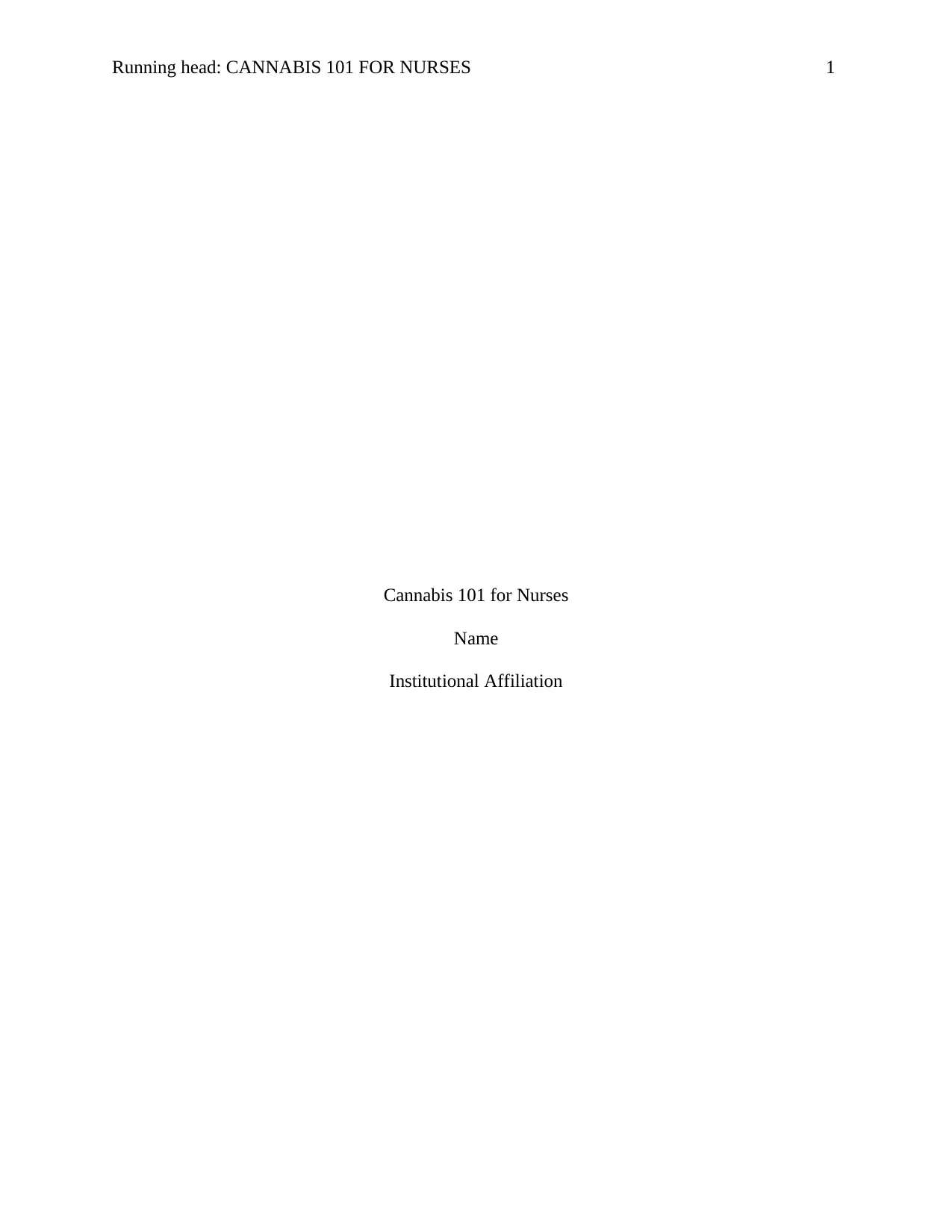
Running head: CANNABIS 101 FOR NURSES 1
Cannabis 101 for Nurses
Name
Institutional Affiliation
Cannabis 101 for Nurses
Name
Institutional Affiliation
Paraphrase This Document
Need a fresh take? Get an instant paraphrase of this document with our AI Paraphraser

CANNABIS 101 FOR NURSES 2
CANNABIS 101 FOR NURSES
How Cannabis Works
Marijuana works through an endocannabinoid (EC) system. The system is named after
marijuana plant Cannabis sativa alongside its ingredient delta-9-tetrahydrocannabinol (THC). EC
system remains a distinct communication system in body and brain which affects such functions
as how an individual feels, reacts and moves. The body yields cannabinoids, natural chemicals
that interact within the EC system (Schlosser et al., 2017). Like THC, cannabinoids interact with
receptors in the brain for the regulation of such functions. Cannabinoids work distinguished from
other neurotransmitters. The EC system will communicate its messages uniquely since it
functions “backward.” The EC system’s cannabinoids are made “on demand” when a
postsynaptic neuron becomes activated from lipid precursors in the neuron (Zamberletti,
Gabaglio & Parolaro, 2017). They are released and travel backward to presynaptic neuron hence
attaching to cannabinoid receptors.
When a patient is administered marijuana, EC system becomes overwhelmed by THC
and rapidly attaching to cannabinoids receptors in the entire body and brain. This disrupts the
natural cannabinoid’s ability to fine-tune communication between neurons thereby throwing the
whole system off-balance (Hietala, 2018). Since these cannabinoid receptors are throughout the
body and brain, THC’s effects are far-reaching. THC affects brain parts which make an
individual feel good which leads to a “high” feeling is.
Endocannabinoid deficiency syndrome is a condition whereby a person yields a lower
cannabinoids amount regarded as necessary in health, well-being and vitality promotion. The
body fails to generate adequate endocannabinoids or sufficient receptors for EC system to
properly function (Vázquez et al., 2015). Thus, the various function is never properly regulated
CANNABIS 101 FOR NURSES
How Cannabis Works
Marijuana works through an endocannabinoid (EC) system. The system is named after
marijuana plant Cannabis sativa alongside its ingredient delta-9-tetrahydrocannabinol (THC). EC
system remains a distinct communication system in body and brain which affects such functions
as how an individual feels, reacts and moves. The body yields cannabinoids, natural chemicals
that interact within the EC system (Schlosser et al., 2017). Like THC, cannabinoids interact with
receptors in the brain for the regulation of such functions. Cannabinoids work distinguished from
other neurotransmitters. The EC system will communicate its messages uniquely since it
functions “backward.” The EC system’s cannabinoids are made “on demand” when a
postsynaptic neuron becomes activated from lipid precursors in the neuron (Zamberletti,
Gabaglio & Parolaro, 2017). They are released and travel backward to presynaptic neuron hence
attaching to cannabinoid receptors.
When a patient is administered marijuana, EC system becomes overwhelmed by THC
and rapidly attaching to cannabinoids receptors in the entire body and brain. This disrupts the
natural cannabinoid’s ability to fine-tune communication between neurons thereby throwing the
whole system off-balance (Hietala, 2018). Since these cannabinoid receptors are throughout the
body and brain, THC’s effects are far-reaching. THC affects brain parts which make an
individual feel good which leads to a “high” feeling is.
Endocannabinoid deficiency syndrome is a condition whereby a person yields a lower
cannabinoids amount regarded as necessary in health, well-being and vitality promotion. The
body fails to generate adequate endocannabinoids or sufficient receptors for EC system to
properly function (Vázquez et al., 2015). Thus, the various function is never properly regulated
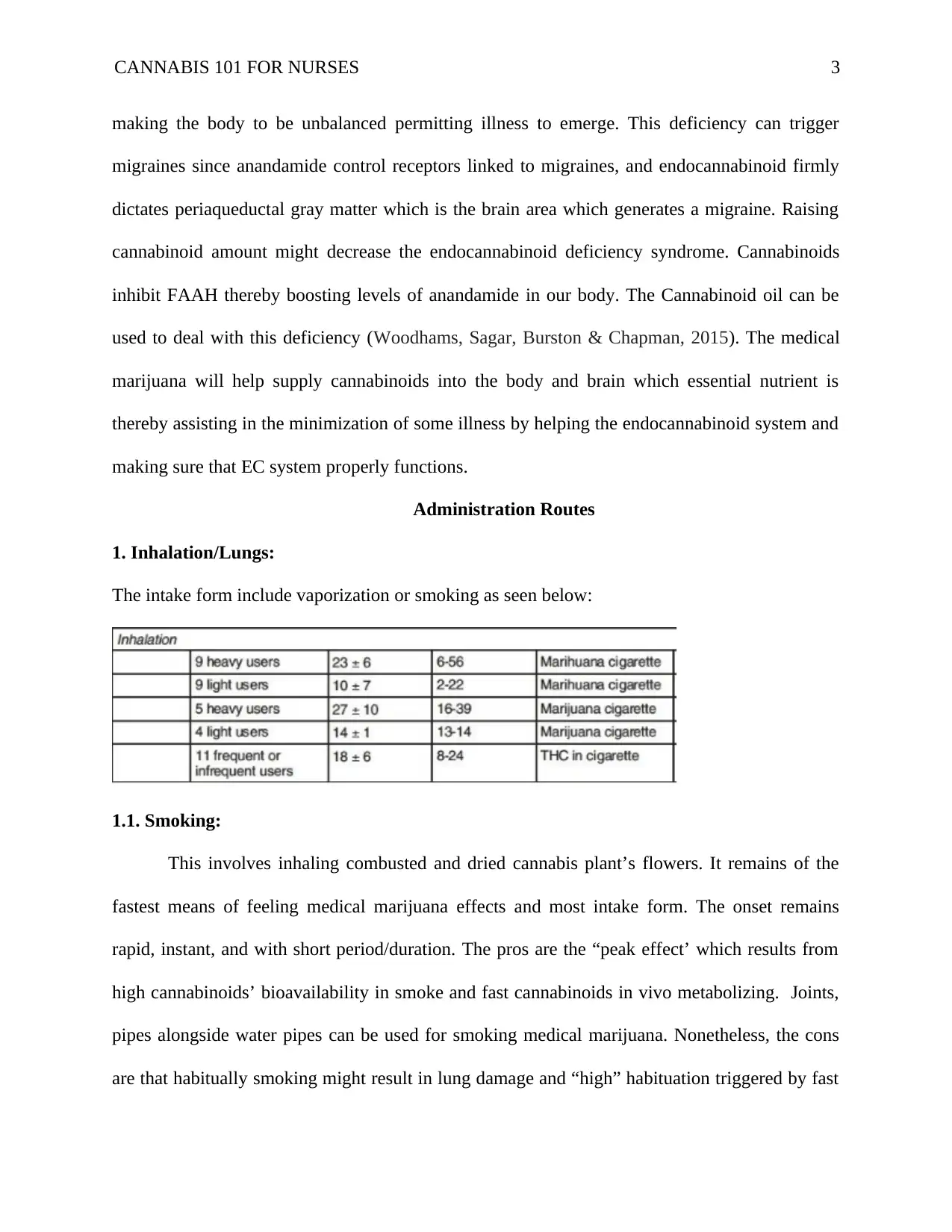
CANNABIS 101 FOR NURSES 3
making the body to be unbalanced permitting illness to emerge. This deficiency can trigger
migraines since anandamide control receptors linked to migraines, and endocannabinoid firmly
dictates periaqueductal gray matter which is the brain area which generates a migraine. Raising
cannabinoid amount might decrease the endocannabinoid deficiency syndrome. Cannabinoids
inhibit FAAH thereby boosting levels of anandamide in our body. The Cannabinoid oil can be
used to deal with this deficiency (Woodhams, Sagar, Burston & Chapman, 2015). The medical
marijuana will help supply cannabinoids into the body and brain which essential nutrient is
thereby assisting in the minimization of some illness by helping the endocannabinoid system and
making sure that EC system properly functions.
Administration Routes
1. Inhalation/Lungs:
The intake form include vaporization or smoking as seen below:
1.1. Smoking:
This involves inhaling combusted and dried cannabis plant’s flowers. It remains of the
fastest means of feeling medical marijuana effects and most intake form. The onset remains
rapid, instant, and with short period/duration. The pros are the “peak effect’ which results from
high cannabinoids’ bioavailability in smoke and fast cannabinoids in vivo metabolizing. Joints,
pipes alongside water pipes can be used for smoking medical marijuana. Nonetheless, the cons
are that habitually smoking might result in lung damage and “high” habituation triggered by fast
making the body to be unbalanced permitting illness to emerge. This deficiency can trigger
migraines since anandamide control receptors linked to migraines, and endocannabinoid firmly
dictates periaqueductal gray matter which is the brain area which generates a migraine. Raising
cannabinoid amount might decrease the endocannabinoid deficiency syndrome. Cannabinoids
inhibit FAAH thereby boosting levels of anandamide in our body. The Cannabinoid oil can be
used to deal with this deficiency (Woodhams, Sagar, Burston & Chapman, 2015). The medical
marijuana will help supply cannabinoids into the body and brain which essential nutrient is
thereby assisting in the minimization of some illness by helping the endocannabinoid system and
making sure that EC system properly functions.
Administration Routes
1. Inhalation/Lungs:
The intake form include vaporization or smoking as seen below:
1.1. Smoking:
This involves inhaling combusted and dried cannabis plant’s flowers. It remains of the
fastest means of feeling medical marijuana effects and most intake form. The onset remains
rapid, instant, and with short period/duration. The pros are the “peak effect’ which results from
high cannabinoids’ bioavailability in smoke and fast cannabinoids in vivo metabolizing. Joints,
pipes alongside water pipes can be used for smoking medical marijuana. Nonetheless, the cons
are that habitually smoking might result in lung damage and “high” habituation triggered by fast
⊘ This is a preview!⊘
Do you want full access?
Subscribe today to unlock all pages.

Trusted by 1+ million students worldwide

CANNABIS 101 FOR NURSES 4
onset alongside dose-response diminishing. Dose accuracy is low, and variability in quality and
consistency effects are of high degree.
1.2. Vaporization:
It is the process via which dried flowers, extract or concentrate of cannabis is gradually
subjected to heat at lower, and the increasingly precise temperature is permitting cannabis
therapeutic ingredient (cannabinoids like THC) to phase-alter into a vapor or gas and extract
from cannabis plant without necessarily burning this plant. A vapor result from this process in
place of smoke. The onset is rapid and instant within seconds. The pros are that vaporization
decreases cannabis use long-term harm and a safer than smoking while allowing a patient to
control his dose better (Cranford, Bohnert, Perron, Bourque & Ilgen, 2016). The cons are that
vaporization doesn’t alter cannabis absorption in our bodies. Like smoking, cannabis will still be
taking via the alveoli. Bioavailability remains high with fair dose accuracy relying on vaporizers’
quality.
2. Oral Administration:
This route uses such intake forms as capsules and edibles as seen below:
2.1. Capsules and Edibles:
The cannabis is infused into cooking oil or butter or other edible fat or sugar alcohol to
yield edible cannabis in capsule or food form. The pros are that edible intake is sometimes
recommended for patients experiencing severe chronic pain since its effects are displayed in
onset alongside dose-response diminishing. Dose accuracy is low, and variability in quality and
consistency effects are of high degree.
1.2. Vaporization:
It is the process via which dried flowers, extract or concentrate of cannabis is gradually
subjected to heat at lower, and the increasingly precise temperature is permitting cannabis
therapeutic ingredient (cannabinoids like THC) to phase-alter into a vapor or gas and extract
from cannabis plant without necessarily burning this plant. A vapor result from this process in
place of smoke. The onset is rapid and instant within seconds. The pros are that vaporization
decreases cannabis use long-term harm and a safer than smoking while allowing a patient to
control his dose better (Cranford, Bohnert, Perron, Bourque & Ilgen, 2016). The cons are that
vaporization doesn’t alter cannabis absorption in our bodies. Like smoking, cannabis will still be
taking via the alveoli. Bioavailability remains high with fair dose accuracy relying on vaporizers’
quality.
2. Oral Administration:
This route uses such intake forms as capsules and edibles as seen below:
2.1. Capsules and Edibles:
The cannabis is infused into cooking oil or butter or other edible fat or sugar alcohol to
yield edible cannabis in capsule or food form. The pros are that edible intake is sometimes
recommended for patients experiencing severe chronic pain since its effects are displayed in
Paraphrase This Document
Need a fresh take? Get an instant paraphrase of this document with our AI Paraphraser
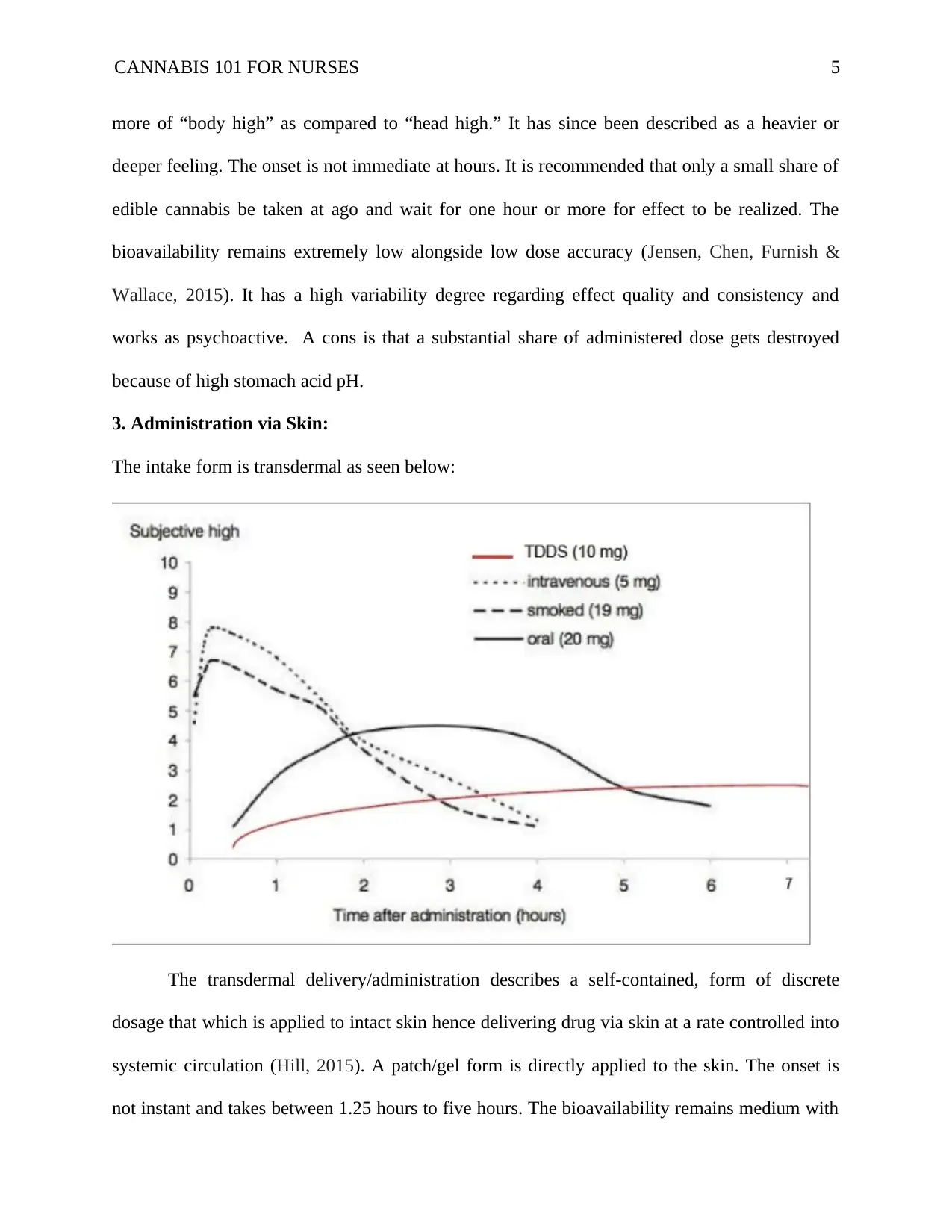
CANNABIS 101 FOR NURSES 5
more of “body high” as compared to “head high.” It has since been described as a heavier or
deeper feeling. The onset is not immediate at hours. It is recommended that only a small share of
edible cannabis be taken at ago and wait for one hour or more for effect to be realized. The
bioavailability remains extremely low alongside low dose accuracy (Jensen, Chen, Furnish &
Wallace, 2015). It has a high variability degree regarding effect quality and consistency and
works as psychoactive. A cons is that a substantial share of administered dose gets destroyed
because of high stomach acid pH.
3. Administration via Skin:
The intake form is transdermal as seen below:
The transdermal delivery/administration describes a self-contained, form of discrete
dosage that which is applied to intact skin hence delivering drug via skin at a rate controlled into
systemic circulation (Hill, 2015). A patch/gel form is directly applied to the skin. The onset is
not instant and takes between 1.25 hours to five hours. The bioavailability remains medium with
more of “body high” as compared to “head high.” It has since been described as a heavier or
deeper feeling. The onset is not immediate at hours. It is recommended that only a small share of
edible cannabis be taken at ago and wait for one hour or more for effect to be realized. The
bioavailability remains extremely low alongside low dose accuracy (Jensen, Chen, Furnish &
Wallace, 2015). It has a high variability degree regarding effect quality and consistency and
works as psychoactive. A cons is that a substantial share of administered dose gets destroyed
because of high stomach acid pH.
3. Administration via Skin:
The intake form is transdermal as seen below:
The transdermal delivery/administration describes a self-contained, form of discrete
dosage that which is applied to intact skin hence delivering drug via skin at a rate controlled into
systemic circulation (Hill, 2015). A patch/gel form is directly applied to the skin. The onset is
not instant and takes between 1.25 hours to five hours. The bioavailability remains medium with

CANNABIS 101 FOR NURSES 6
extremely high dose accuracy and with a high consistency degree in term of effect consistency
and quality. The pros of transdermal are that dose remained pre-loaded and concealed from view
thus no smell, easy to use and no ritual. The administration of the dose rate remains reliable and
consistent taking place slowly over a set timeframe. The cons is that time to onset is longer.
4. Sublingual Administration
This is delivered under a patient’s tongue (sublingual) or in the oral cavity (oromucosal)
as a method of tincture or oil. The onset is rapid since the medication is absorbed into the
patient’s blood system (Bruce, Brady, Foster & Shattell, 2018). The pros are that effect
consistency, and quality is high and with high dose accuracy. It is also comfortable for patients
who never smoke cigarettes. The cons are that tinctures must first be prepared in oil, glycerol or
oil base.
extremely high dose accuracy and with a high consistency degree in term of effect consistency
and quality. The pros of transdermal are that dose remained pre-loaded and concealed from view
thus no smell, easy to use and no ritual. The administration of the dose rate remains reliable and
consistent taking place slowly over a set timeframe. The cons is that time to onset is longer.
4. Sublingual Administration
This is delivered under a patient’s tongue (sublingual) or in the oral cavity (oromucosal)
as a method of tincture or oil. The onset is rapid since the medication is absorbed into the
patient’s blood system (Bruce, Brady, Foster & Shattell, 2018). The pros are that effect
consistency, and quality is high and with high dose accuracy. It is also comfortable for patients
who never smoke cigarettes. The cons are that tinctures must first be prepared in oil, glycerol or
oil base.
⊘ This is a preview!⊘
Do you want full access?
Subscribe today to unlock all pages.

Trusted by 1+ million students worldwide
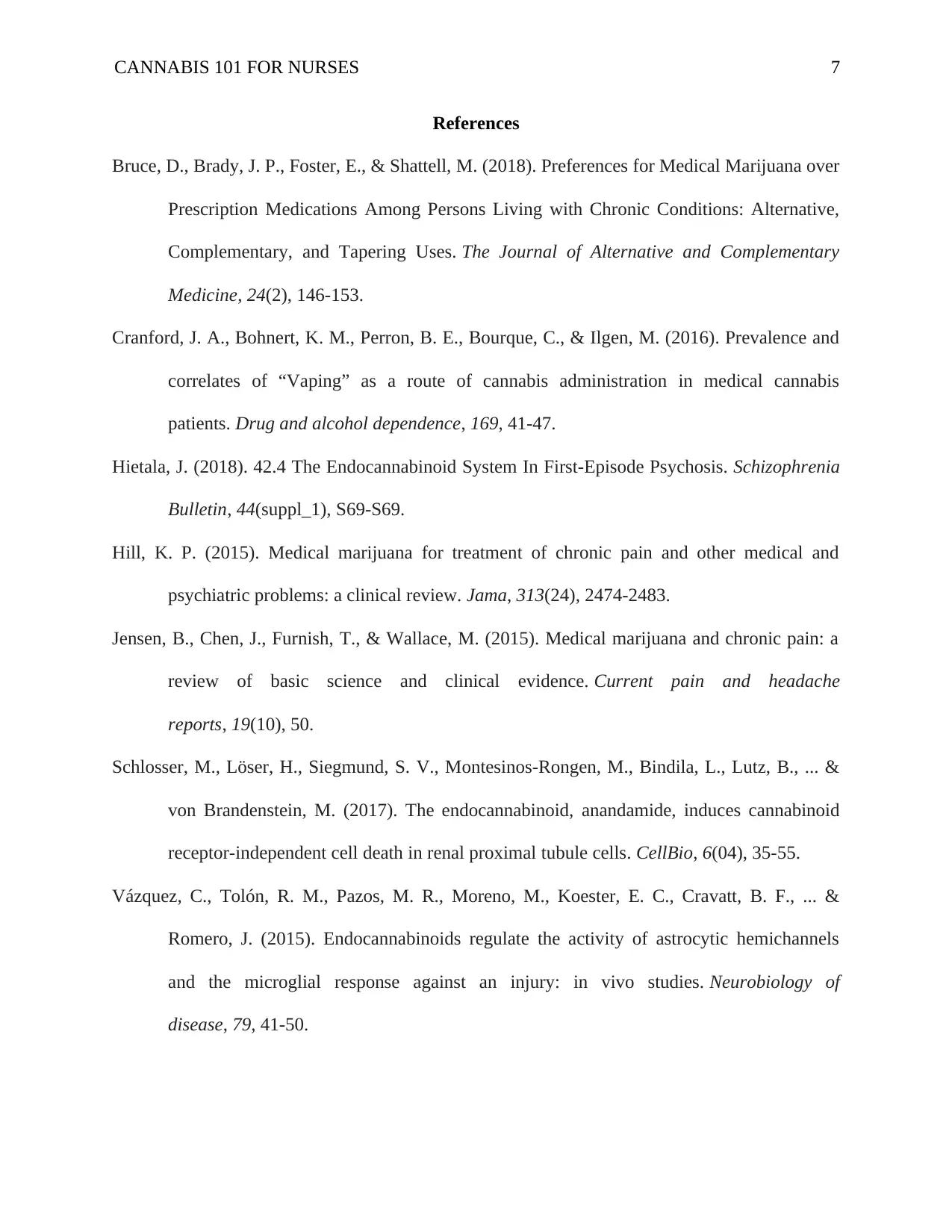
CANNABIS 101 FOR NURSES 7
References
Bruce, D., Brady, J. P., Foster, E., & Shattell, M. (2018). Preferences for Medical Marijuana over
Prescription Medications Among Persons Living with Chronic Conditions: Alternative,
Complementary, and Tapering Uses. The Journal of Alternative and Complementary
Medicine, 24(2), 146-153.
Cranford, J. A., Bohnert, K. M., Perron, B. E., Bourque, C., & Ilgen, M. (2016). Prevalence and
correlates of “Vaping” as a route of cannabis administration in medical cannabis
patients. Drug and alcohol dependence, 169, 41-47.
Hietala, J. (2018). 42.4 The Endocannabinoid System In First-Episode Psychosis. Schizophrenia
Bulletin, 44(suppl_1), S69-S69.
Hill, K. P. (2015). Medical marijuana for treatment of chronic pain and other medical and
psychiatric problems: a clinical review. Jama, 313(24), 2474-2483.
Jensen, B., Chen, J., Furnish, T., & Wallace, M. (2015). Medical marijuana and chronic pain: a
review of basic science and clinical evidence. Current pain and headache
reports, 19(10), 50.
Schlosser, M., Löser, H., Siegmund, S. V., Montesinos-Rongen, M., Bindila, L., Lutz, B., ... &
von Brandenstein, M. (2017). The endocannabinoid, anandamide, induces cannabinoid
receptor-independent cell death in renal proximal tubule cells. CellBio, 6(04), 35-55.
Vázquez, C., Tolón, R. M., Pazos, M. R., Moreno, M., Koester, E. C., Cravatt, B. F., ... &
Romero, J. (2015). Endocannabinoids regulate the activity of astrocytic hemichannels
and the microglial response against an injury: in vivo studies. Neurobiology of
disease, 79, 41-50.
References
Bruce, D., Brady, J. P., Foster, E., & Shattell, M. (2018). Preferences for Medical Marijuana over
Prescription Medications Among Persons Living with Chronic Conditions: Alternative,
Complementary, and Tapering Uses. The Journal of Alternative and Complementary
Medicine, 24(2), 146-153.
Cranford, J. A., Bohnert, K. M., Perron, B. E., Bourque, C., & Ilgen, M. (2016). Prevalence and
correlates of “Vaping” as a route of cannabis administration in medical cannabis
patients. Drug and alcohol dependence, 169, 41-47.
Hietala, J. (2018). 42.4 The Endocannabinoid System In First-Episode Psychosis. Schizophrenia
Bulletin, 44(suppl_1), S69-S69.
Hill, K. P. (2015). Medical marijuana for treatment of chronic pain and other medical and
psychiatric problems: a clinical review. Jama, 313(24), 2474-2483.
Jensen, B., Chen, J., Furnish, T., & Wallace, M. (2015). Medical marijuana and chronic pain: a
review of basic science and clinical evidence. Current pain and headache
reports, 19(10), 50.
Schlosser, M., Löser, H., Siegmund, S. V., Montesinos-Rongen, M., Bindila, L., Lutz, B., ... &
von Brandenstein, M. (2017). The endocannabinoid, anandamide, induces cannabinoid
receptor-independent cell death in renal proximal tubule cells. CellBio, 6(04), 35-55.
Vázquez, C., Tolón, R. M., Pazos, M. R., Moreno, M., Koester, E. C., Cravatt, B. F., ... &
Romero, J. (2015). Endocannabinoids regulate the activity of astrocytic hemichannels
and the microglial response against an injury: in vivo studies. Neurobiology of
disease, 79, 41-50.
Paraphrase This Document
Need a fresh take? Get an instant paraphrase of this document with our AI Paraphraser
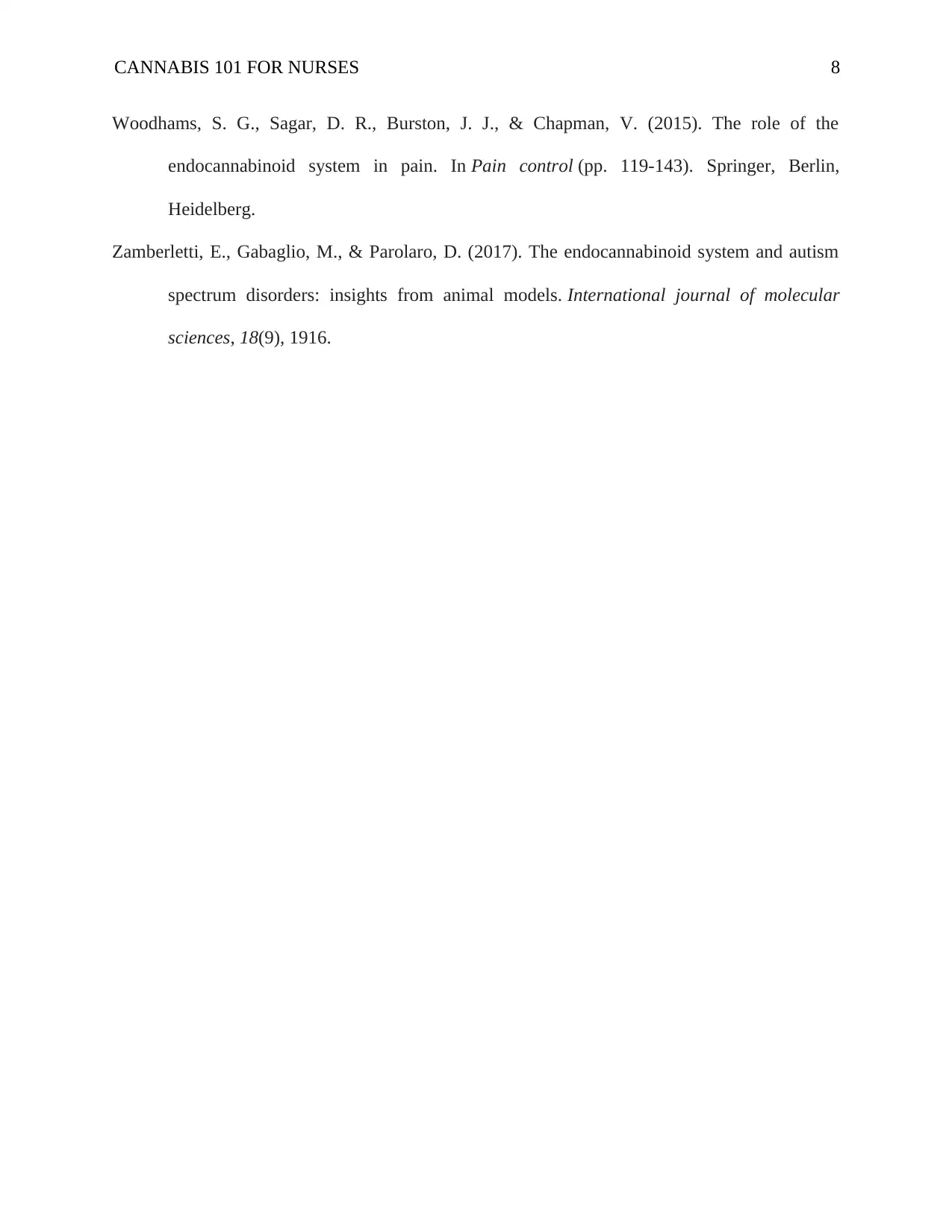
CANNABIS 101 FOR NURSES 8
Woodhams, S. G., Sagar, D. R., Burston, J. J., & Chapman, V. (2015). The role of the
endocannabinoid system in pain. In Pain control (pp. 119-143). Springer, Berlin,
Heidelberg.
Zamberletti, E., Gabaglio, M., & Parolaro, D. (2017). The endocannabinoid system and autism
spectrum disorders: insights from animal models. International journal of molecular
sciences, 18(9), 1916.
Woodhams, S. G., Sagar, D. R., Burston, J. J., & Chapman, V. (2015). The role of the
endocannabinoid system in pain. In Pain control (pp. 119-143). Springer, Berlin,
Heidelberg.
Zamberletti, E., Gabaglio, M., & Parolaro, D. (2017). The endocannabinoid system and autism
spectrum disorders: insights from animal models. International journal of molecular
sciences, 18(9), 1916.
1 out of 8
Your All-in-One AI-Powered Toolkit for Academic Success.
+13062052269
info@desklib.com
Available 24*7 on WhatsApp / Email
![[object Object]](/_next/static/media/star-bottom.7253800d.svg)
Unlock your academic potential
Copyright © 2020–2025 A2Z Services. All Rights Reserved. Developed and managed by ZUCOL.
